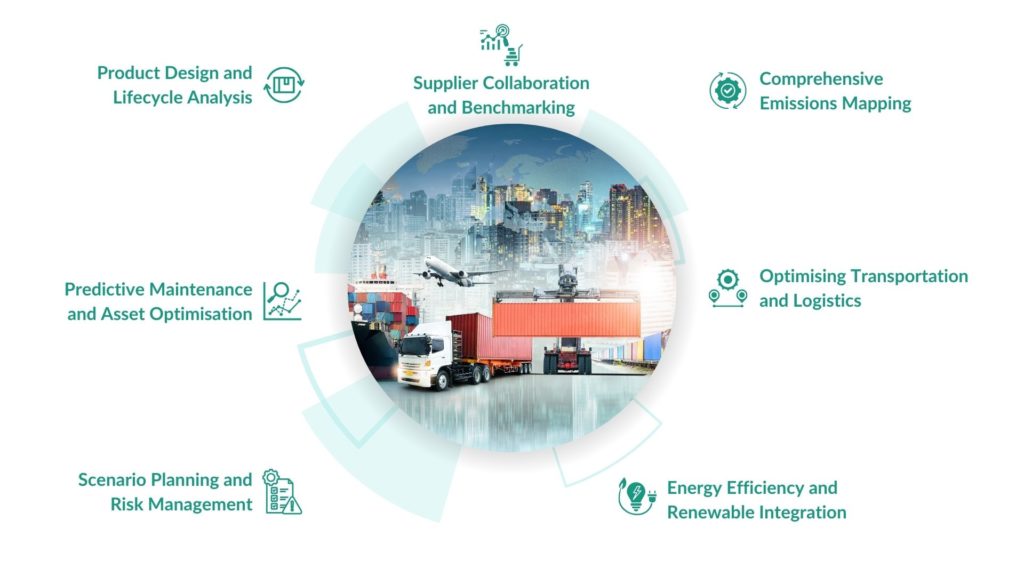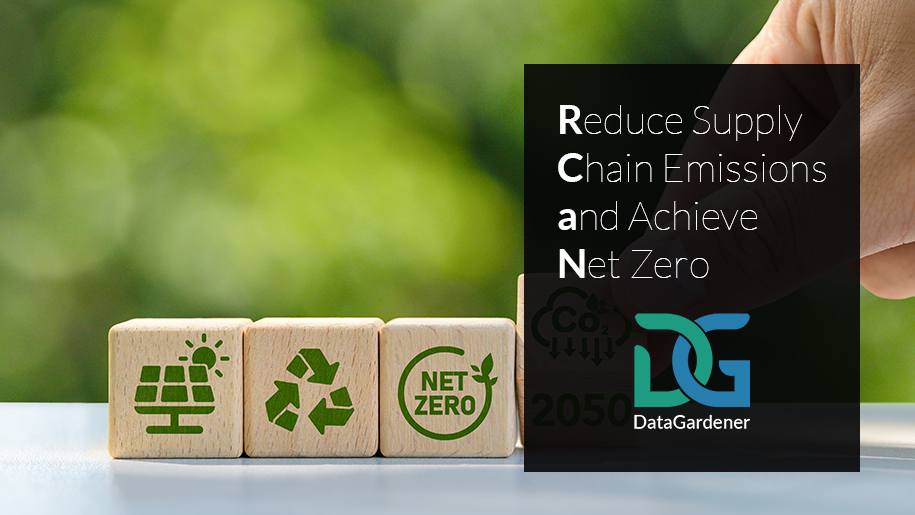Companies increasingly focus on reducing their carbon footprint and achieving net-zero emissions in today’s climate-conscious business environment. A significant portion of a company’s environmental impact often lies within its supply chain emissions. Using data insights, organisations can make informed decisions to lower emissions and work towards their sustainability goals.
Supply chain emissions have become a significant contributor to global climate change. Understanding and reducing these emissions is crucial for businesses to reach net zero. This article will explore how data insights can help lower supply chain emissions, the solutions for managing these emissions, and how companies can reach net zero.
What Are Supply Chain Emissions?
Supply chain emissions, or indirect emissions, are the greenhouse gases (GHGs) produced by a company’s supply chain activities. This includes everything from the extraction of raw materials to the transportation and delivery of final products to customers.
Types of Supply Chain Emissions
There are three main types of emissions that companies need to consider:
Scope 1: Direct emissions from owned or controlled sources.
Scope 2: Indirect emissions from the generation of purchased energy.
Scope 3: All other indirect emissions, such as transportation, waste disposal, and supplier activities.
The Role of Scope 3 Emissions
Scope 3 emissions are often the largest emissions category in a company’s supply chain. They include everything from the energy used by suppliers to the emissions generated by consumers using a product. Addressing these emissions requires detailed data and collaboration across the supply chain.
7 Key Strategies for Sustainable Supply Chain Emissions

1. Comprehensive Emissions Mapping
The first step in reducing supply chain emissions is to gain a clear understanding of where they originate. Advanced data analytics tools can help companies:
- Track emissions across the entire supply chain, from raw material sourcing to final product delivery
- Identify hotspots and prioritise areas for improvement
- Create detailed carbon footprint reports for each supplier and process
Companies can gather and process real-time data on energy consumption, transportation routes, and production processes by utilising IoT sensors, blockchain technology, and AI-powered analytics.
2. Supplier Collaboration and Benchmarking
Data-driven insights enable businesses to:
- Compare supplier performance on sustainability metrics
- Set benchmarks and incentivise improvements
- Collaborate with suppliers to implement best practices
Companies and suppliers can collaborate to reduce emissions throughout the value chain by sharing data and setting common goals.
3. Optimising Transportation and Logistics
Transportation is often a significant contributor to supply chain emissions. Data analytics can help by:
- Optimising route planning to reduce fuel consumption
- Identifying opportunities for mode shifting (e.g., from air to sea freight)
- Improving load factors and reducing empty miles
Machine learning algorithms can process vast amounts of historical and real-time data to suggest the most efficient and eco-friendly logistics solutions.
4. Energy Efficiency and Renewable Integration
Data insights can drive energy efficiency improvements and facilitate the integration of renewable energy sources:
- Identify energy-intensive processes and equipment
- Optimise energy consumption patterns
- Assess the feasibility and impact of integrating renewable energy sources
Smart meters and energy management systems provide valuable data for making informed energy use and sourcing decisions.
5. Product Design and Lifecycle Analysis
Data-driven lifecycle assessments can inform product design decisions:
- Analyse the environmental impact of different materials and manufacturing processes
- Identify opportunities for circular economy principles (reuse, recycle, refurbish)
- Optimise packaging to reduce waste and emissions
By considering emissions throughout a product’s lifecycle, companies can make design choices that have a lasting positive impact on their carbon footprint.
6. Predictive Maintenance and Asset Optimisation
Leveraging data for predictive maintenance can reduce emissions by:
- Preventing equipment breakdowns that lead to inefficiencies
- Optimising asset performance and energy consumption
- Extending the lifespan of machinery, reducing the need for replacements
IoT sensors and AI algorithms can predict maintenance needs and optimise asset performance, reducing energy consumption and waste.
7. Scenario Planning and Risk Management
Data analytics enable companies to:
- Model different scenarios and their impact on emissions
- Assess climate-related risks in the supply chain
- Develop robust strategies for achieving net-zero goals
Using data to inform long-term planning, businesses can make strategic decisions aligning with their sustainability objectives.
Case Studies: Companies Reducing Supply Chain Emissions
Several major corporations have significantly reduced their supply chain emissions through data-driven strategies.
Example 1: Walmart’s Sustainability Initiatives
Walmart, one of the largest global retailers, has committed to reducing one gigaton of emissions from its global supply chain by 2030. Walmart has achieved substantial emission reductions by using data to engage suppliers and track progress.
Example 2: Unilever’s Net Zero Journey
Unilever has committed to achieving net zero emissions across its value chain by 2039. By using advanced data analytics to monitor the emissions of its suppliers and transportation, Unilever is on track to meet its sustainability goals.
Challenges in Reducing Supply Chain Emissions
While data provides valuable insights, reducing supply chain emissions is challenging.
Data Gaps and Inconsistencies
Many companies need more complete or accurate data. Suppliers may require more resources to track their emissions accurately, making it difficult for businesses to fully understand their supply chain’s carbon footprint.
Supplier Engagement and Transparency
Engaging suppliers and ensuring they adopt sustainable practices can be challenging. Often, suppliers are located in regions with less stringent environmental regulations, which can hinder progress.
Collaborative Approaches to Achieving Net Zero in Supply Chains
Achieving net zero requires collaboration across the entire supply chain. Companies must work closely with suppliers, logistics providers, and other stakeholders to drive meaningful change.
Partnerships with Suppliers
Forming partnerships with suppliers to share data, best practices, and technology can help both parties reduce their emissions. Collaborative platforms that allow companies and suppliers to track progress in real-time can facilitate these efforts.
Engaging Stakeholders in Sustainability
Sustainability needs to be a shared goal, not just a corporate objective. Engaging employees, consumers, and investors in sustainability initiatives ensures that everyone is working towards the same goal of reducing emissions.
How Businesses Can Get Started on Reducing Supply Chain Emissions
Reducing supply chain emissions can seem daunting, but businesses can progress significantly with the right data and strategy.
Conducting a Supply Chain Emissions Audit
The first step is to conduct an emissions audit to identify the biggest sources of emissions in the supply chain. This can involve gathering data from suppliers, manufacturing plants, and logistics providers.
Setting Data-Driven Emission Reduction Targets
Based on the audit, companies can set data-driven targets for reducing emissions. These targets should be realistic and time-bound, with clear milestones for tracking progress.
The Economic Benefits of Reducing Supply Chain Emissions
Beyond the environmental impact, reducing supply chain emissions can offer significant financial benefits.
Cost Savings Through Efficient Operations
Simplifying supply chain operations through data insights can result in lower fuel costs, reduced waste, and more efficient resource use, which in turn can result in cost savings.
Attracting Eco-Conscious Consumers and Investors
Consumers and investors are increasingly looking for companies that prioritise sustainability. Reducing supply chain emissions can help companies attract new customers and investment opportunities.
Overcoming Barriers to Achieving Net Zero Supply Chains
While reducing emissions is important, businesses must overcome several barriers to achieve net zero.
Addressing Cost Constraints
Implementing sustainable practices can sometimes require upfront investment. However, the long-term savings from reduced energy use and improved operational efficiency often outweigh these costs.
Aligning Business Goals with Climate Objectives
Aligning sustainability goals with business objectives is key to long-term success. Companies must ensure that reducing emissions doesn’t conflict with other business priorities, such as profitability.
Conclusion
Reaching net-zero emissions in the supply chain is challenging, but data can help make it easier. By using tools like AI, IoT, and data analysis, companies can better understand their emissions, make intelligent choices, and take steps toward being more sustainable. As technology improves, businesses that use these tools will lead the way to a low-carbon future.
Using data is essential to cutting supply chain emissions. With the right tools, companies can track their emissions, improve operations, and work with suppliers to hit their sustainability targets. Although the path to net zero is tricky, using data helps the environment and boosts business success.
